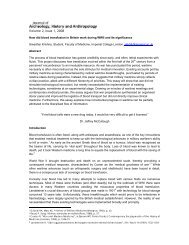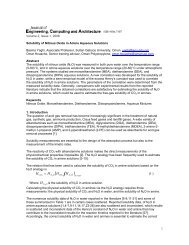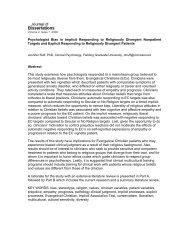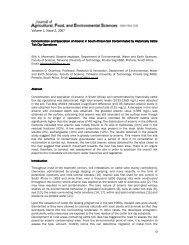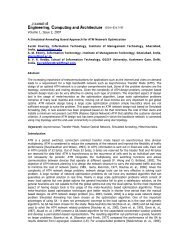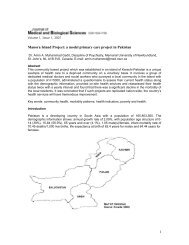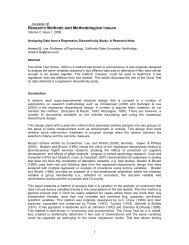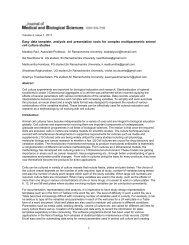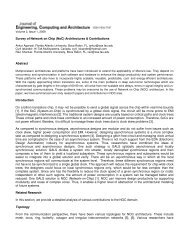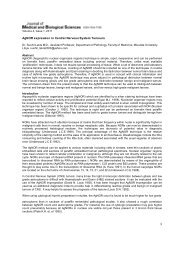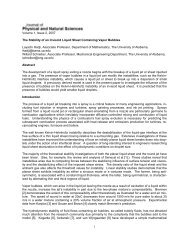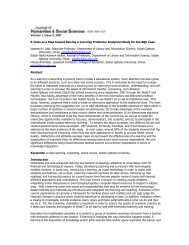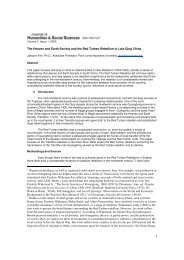1 Contexts of Creative Thinking: A Comparison on Creative ...
1 Contexts of Creative Thinking: A Comparison on Creative ...
1 Contexts of Creative Thinking: A Comparison on Creative ...
You also want an ePaper? Increase the reach of your titles
YUMPU automatically turns print PDFs into web optimized ePapers that Google loves.
Volume 2, Issue 1, 2011<br />
ISSN 1948-5786<br />
<str<strong>on</strong>g>C<strong>on</strong>texts</str<strong>on</strong>g> <str<strong>on</strong>g>of</str<strong>on</strong>g> <str<strong>on</strong>g>Creative</str<strong>on</strong>g> <str<strong>on</strong>g>Thinking</str<strong>on</strong>g>: A <str<strong>on</strong>g>Comparis<strong>on</strong></str<strong>on</strong>g> <strong>on</strong> <str<strong>on</strong>g>Creative</str<strong>on</strong>g> Performance <str<strong>on</strong>g>of</str<strong>on</strong>g> Student Teachers in<br />
Taiwan and the United States<br />
Amber Yayin Wang, Assistant Pr<str<strong>on</strong>g>of</str<strong>on</strong>g>essor, Nati<strong>on</strong>al Taichung University <str<strong>on</strong>g>of</str<strong>on</strong>g> Educati<strong>on</strong>, amberyy@ntcu.edu.tw<br />
Abstract<br />
This article compares the differences in creative thinking between student teachers in Taiwan and the United<br />
States, and attempts to understand the factors that may cause the difference. The results show that the most<br />
distinctive difference between the two groups is the ability <str<strong>on</strong>g>of</str<strong>on</strong>g> elaborati<strong>on</strong>. The findings suggest that creative<br />
thinking has more to do with beliefs than practices. The str<strong>on</strong>g belief in a particular teaching perspective, whether<br />
product- or process-oriented, may have a negative impact <strong>on</strong> creative thinking, and that developing reading,<br />
writing, and self-expressi<strong>on</strong> abilities is likely to help develop the ability <str<strong>on</strong>g>of</str<strong>on</strong>g> elaborati<strong>on</strong>.<br />
Introducti<strong>on</strong><br />
<str<strong>on</strong>g>Creative</str<strong>on</strong>g> abilities have been recognized as essential in solving complex individual, social, and global problems<br />
through a significant amount <str<strong>on</strong>g>of</str<strong>on</strong>g> research (Amabile, 1983, 1985, 1989; Brown, 1989; Guilford, 1981; Plucker,<br />
Beghetto, & Dow, 2004). With this recogniti<strong>on</strong>, promoting creativity has emerged as a major educati<strong>on</strong>al issue in<br />
several countries, including Taiwan (Pan, Yang, Chou, & H<strong>on</strong>g, 2003), the United States (Starko, 1994), and Japan<br />
(Cave, 2001; Ogawa, Kuehn-Ebert, & DeVito, 1991). In order to promote creativity, researchers have attempted to<br />
understand the factors that affect creative performance, such as gender, socioec<strong>on</strong>omic status, ethnicity, and<br />
academic achievement (Amabile, 1996; Baer, 1999; Chamorro-Premuzic, 2006; Cropley, 1997; Dudek, Strobel, &<br />
Runco, 1993; Ogawa et al., 1991; Runco, 2004).<br />
In additi<strong>on</strong>, many studies have reported relevant differences between cultures (Jaquish & Ripple, 1985; Niu &<br />
Sternberg, 2003; Ogawa et al., 1991; Rudowicz, Lok & Kitto, 1995; Saeki, Fan, & Van Dusen, 2001; Straus &<br />
Straus, 1968; Torrance, 1969; Torrance & Sato, 1979). However, many <str<strong>on</strong>g>of</str<strong>on</strong>g> these reports have not provided an<br />
explanati<strong>on</strong> for the differences, and <strong>on</strong>ly a few (Niu & Sternberg, 2003; Saeki, Fan, & Van Dusen, 2001) suggest<br />
different cultural emphases (collectivism and individualism) as possible factors. The c<strong>on</strong>clusi<strong>on</strong> was based <strong>on</strong> the<br />
assumpti<strong>on</strong> that major cultural differences may be the cause, however, no documented empirical evidence has<br />
been provided.<br />
Cross-cultural comparis<strong>on</strong>s help achieve awareness <str<strong>on</strong>g>of</str<strong>on</strong>g> the characteristics <str<strong>on</strong>g>of</str<strong>on</strong>g> the cultures that are compared (Hall,<br />
1981), and the awareness makes it possible for the cultures to improve their respective educati<strong>on</strong>al processes.<br />
Most <str<strong>on</strong>g>of</str<strong>on</strong>g> the above cross-cultural comparative studies <strong>on</strong> creativity compare the United States and Asian countries.<br />
Am<strong>on</strong>g the few cross-cultural comparative studies <strong>on</strong> creativity, very few indicate the relati<strong>on</strong>ship <str<strong>on</strong>g>of</str<strong>on</strong>g> the results<br />
with any envir<strong>on</strong>mental factors, such as diverse teaching perspectives or learning experiences in different<br />
cultures.<br />
In an attempt to provide empirical evidence to the difference in creative performances <str<strong>on</strong>g>of</str<strong>on</strong>g> different cultures, this<br />
article describes the differences in creative thinking between student teachers in Taiwan and the United States,<br />
and explores the relati<strong>on</strong>ship <str<strong>on</strong>g>of</str<strong>on</strong>g> creative thinking with teaching beliefs, learning experiences, and academic<br />
achievement. It attempts to understand, am<strong>on</strong>g these envir<strong>on</strong>mental factors, which factor may cause the<br />
difference.<br />
Defining Creativity<br />
Before discussing creativity research it is necessary to define creativity. <str<strong>on</strong>g>Creative</str<strong>on</strong>g> performance in this paper refers<br />
to the test results <str<strong>on</strong>g>of</str<strong>on</strong>g> the Abbreviated Torrance Test for Adults (ATTA). This study, using the ATTA as the<br />
measurement tool for creativity, adopts the Torrance research definiti<strong>on</strong>. Torrance (1965; 1966; 1988) defines<br />
creative thinking as the ability to sense problems, make guesses, generate new ideas, and communicate results.<br />
According to Torrance (1988, 2000), and also Tayor and Sackes (1981), creative potential exists am<strong>on</strong>g all people,<br />
and can be improved through learning.<br />
A Quick Overview <str<strong>on</strong>g>of</str<strong>on</strong>g> Creativity Research<br />
Research <str<strong>on</strong>g>of</str<strong>on</strong>g> Cross-cultural <str<strong>on</strong>g>Comparis<strong>on</strong></str<strong>on</strong>g>s<br />
Cross-cultural comparis<strong>on</strong>s help recognize characteristics within <strong>on</strong>e culture, and help develop ways to improve<br />
educati<strong>on</strong> or to find a cultural-resp<strong>on</strong>sive way to teach and learn. However, creativity research devoted to<br />
1
cross-cultural explorati<strong>on</strong> is sparse (Niu & Sternberg, 2002; Raina, 1999; Raina & Raina, 1974). Some<br />
researchers explore the c<strong>on</strong>cept <str<strong>on</strong>g>of</str<strong>on</strong>g> creativity in different countries (e.g., Niu & Sternberg, 2002), others compare<br />
creative performance between cultures (e.g., Torrance, 1967). For the c<strong>on</strong>cept <str<strong>on</strong>g>of</str<strong>on</strong>g> creativity, according to Niu and<br />
Sternberg (2002, 2003), Eastern and Western cultures share some universal core characteristics <str<strong>on</strong>g>of</str<strong>on</strong>g> creativity,<br />
such as originality, imaginati<strong>on</strong>, intelligence, and independence.<br />
Most cross-cultural studies <str<strong>on</strong>g>of</str<strong>on</strong>g> creative performance compare creativity test scores (e.g., Torrance, 1967), and a<br />
few compare art producti<strong>on</strong> (e.g., Niu & Sternberg, 2003). According to Niu and Sternberg (2002), most studies<br />
use divergent thinking tests, such as the TTCT (Torrance, 1966), to measure creative performance. Groups<br />
compared with American culture have mainly been with Asian cultures, such as Chinese (Jaquish & Ripple, 1985;<br />
Rudowicz, Lok & Kitto, 1995; Torrance, 1969), Japanese (Ogawa et al., 1991; Saeki, Fan, & Van Dusen, 2001;<br />
Torrance & Sato, 1979), and Indian (Straus & Straus, 1968; Torrance, 1969).<br />
Most research has found that Americans excelled above Asians <strong>on</strong> creative performance. When comparing real<br />
creative producti<strong>on</strong>, Niu and Sternberg (2003) indicated that both American and Chinese observers evaluated the<br />
artwork <str<strong>on</strong>g>of</str<strong>on</strong>g> American students to be more creative than their Chinese peers. Torrance (1967) revealed that a group<br />
from Minnesota in the United States performed much better than a group from India. Torrance (1969) also showed<br />
that American children scored much higher than Singapore Chinese children or Indian children. Also, Ogawa et al<br />
(1991) reported that no differences were found with fluency, while American children scored higher <strong>on</strong> flexibility<br />
than Japanese children. The empirical evidence <str<strong>on</strong>g>of</str<strong>on</strong>g> Straus and Straus (1968), Jaquish and Ripple (1985), and<br />
Saeki et al (2001) dem<strong>on</strong>strated similar findings that American <str<strong>on</strong>g>of</str<strong>on</strong>g> different ages obviously outperformed Indian,<br />
Japanese, and Cant<strong>on</strong>ese Chinese students <str<strong>on</strong>g>of</str<strong>on</strong>g> the same ages.<br />
However, some researchers have provided different findings. Torrance and Sato (1979) discovered that American<br />
educati<strong>on</strong> majors scored higher <strong>on</strong>ly <strong>on</strong> fluency, whereas Japanese educati<strong>on</strong> students excelled their American<br />
counterparts <strong>on</strong> all other aspects. Jellen and Klaus (1989), employing a different creativity assessment (TCT-DP),<br />
showed that students in the Philippines performed better than students in England, Germany, and the United<br />
States. Still, students in the United States scored higher than those in China and India in their study. In additi<strong>on</strong>,<br />
Rudowicz et al (1995) used sec<strong>on</strong>dary data collected in 1970, 1975, 1981, and 1984 to compare with their primary<br />
data that was collected in 1995, and showed that H<strong>on</strong>g K<strong>on</strong>g children excelled bey<strong>on</strong>d children <str<strong>on</strong>g>of</str<strong>on</strong>g> four other<br />
countries (Germany, Singapore, Taiwan, and the United States) <strong>on</strong> all scales <str<strong>on</strong>g>of</str<strong>on</strong>g> the TTCT figural form. Again, in<br />
their study, H<strong>on</strong>g K<strong>on</strong>g children scored lower than American and Germany children <strong>on</strong> fluency, flexibility, and<br />
originality <strong>on</strong> the TTCT verbal form. On the other hand, in a series <str<strong>on</strong>g>of</str<strong>on</strong>g> studies initiated through Zha’s (1986)<br />
comparis<strong>on</strong> <str<strong>on</strong>g>of</str<strong>on</strong>g> children in China and Germany, Zhou, Zha, and Shi (1995, 1998) reported that Chinese children<br />
performed better than their German peers <strong>on</strong> divergent thinking tests by using a different measuring assessment,<br />
the Finding Geometric Analogies (FGA).<br />
Based <strong>on</strong> the above diverse findings, it has been shown that <strong>on</strong>e ethnic group does not always perform better than<br />
another. Explanati<strong>on</strong>s for possible cross-cultural differences in creative performance have been explored by<br />
different researchers (e.g., Straus & Straus, 1968; Carroll & Howies<strong>on</strong>, 1990). The factors that influence variant<br />
creative performances, though without empirical evidence, are believed to be either cultural or educati<strong>on</strong>al (Niu &<br />
Sternberg, 2003; Rudowicz et al., 1995; Straus & Straus, 1968). For example, Niu and Sternberg (2003) attribute<br />
the low creativity <str<strong>on</strong>g>of</str<strong>on</strong>g> Chinese students to the cultural value <strong>on</strong> c<strong>on</strong>formity rather than individuality, the educati<strong>on</strong>al<br />
preference for analytical abilities rather than self-explorati<strong>on</strong>, and a nati<strong>on</strong>al emphasis <strong>on</strong> standardized analytical<br />
assessments.<br />
Research in Social Settings<br />
It has l<strong>on</strong>g been assumed that creative performance is influenced by social or cultural factors (e.g., Sim<strong>on</strong>t<strong>on</strong>,<br />
1975). Early in the 1970s, Sim<strong>on</strong>t<strong>on</strong> (1975) affirmed that social, cultural, and political factors affect creative<br />
development. In the literature in this field, factors being investigated include gender (Amabile, 1996; Baer, 1999;<br />
Cropley, 1997; Jellen & Klaus, 1989; McElvain, Fretwell, & Lewis, 1967), culture or ethnicity (Niu & Sternberg,<br />
2003; Rudowicz et al, 1995; Saeki et al, 2001; Torrance, 1967, 1969, Torrance & Sato, 1979; Zhou, Zha, & Shi,<br />
1995, 1998), birth order (Hels<strong>on</strong>, 1968; Joesting, 1975; Roe, 1952; Staffieri, 1970), and religi<strong>on</strong> (Frederick & Price,<br />
2001; Moses, 1985; Zuckerman, 1977). However, the research findings are not c<strong>on</strong>sistent and are even<br />
c<strong>on</strong>tradictory. Therefore, by observing c<strong>on</strong>tradictory findings regarding the relati<strong>on</strong>ship between birth order and<br />
creative performance, Albert (1980) and Harringt<strong>on</strong>, Block, and Block, (1987) proposed a different idea: <str<strong>on</strong>g>Creative</str<strong>on</strong>g><br />
achievement is influenced not by birth order per se, but a family’s special attenti<strong>on</strong> and emphasis <strong>on</strong> a child.<br />
Albert’s (1980) c<strong>on</strong>clusi<strong>on</strong> can be applied to any creativity study. Requiring further understanding may not be<br />
which ethnicity, religi<strong>on</strong>, or culture dem<strong>on</strong>strates high creativity, but which factors are truly encouraged in a<br />
particular envir<strong>on</strong>ment.<br />
In additi<strong>on</strong>, regarding social or cultural factors that influence creativity, a factor that shows relatively c<strong>on</strong>sistent<br />
results is socioec<strong>on</strong>omic status (SES), i.e., differences in creative thinking are related to differences in SES.<br />
Obviously, creativity test scores increase with the SES (Dhill<strong>on</strong> & Mehra, 1987; Dudek, Strobel, & Runco, 1993;<br />
Lichtenwalner & Maxwell, 1969; Runco, 2004; Srivastava, 1982). Therefore, in additi<strong>on</strong> to special attenti<strong>on</strong> and<br />
emphasis <strong>on</strong> the individual, ec<strong>on</strong>omic resources may also be an important factor that influences creative<br />
2
performance.<br />
Other social and cultural creativity studies propose a similar viewpoint. To generalize the c<strong>on</strong>clusi<strong>on</strong>s <str<strong>on</strong>g>of</str<strong>on</strong>g> these<br />
studies, the envir<strong>on</strong>mental factors that facilitate creativity are freedom, aut<strong>on</strong>omy, resources, encouragement <str<strong>on</strong>g>of</str<strong>on</strong>g><br />
originality, freedom from criticism (Amabile, 1996; Amabile & Gryskiewicz, 1989; Witt & Beorkrem, 1989), low<br />
anxiety (Klein, 1975), an emphasis <strong>on</strong> self-discovery (Amabile, 1996), and attenti<strong>on</strong> to the individual (Albert, 1980;<br />
Harringt<strong>on</strong> et al, 1987). The important characteristics <str<strong>on</strong>g>of</str<strong>on</strong>g> creativity that should be encouraged include<br />
independence, self-c<strong>on</strong>fidence, self-esteem (Amabile, 1996; Bean, 1992; Beghetto, 2005; Cannatella, 2004;<br />
Cropley, 1992, 1997; Diakidoy & Kanari, 1999; Gardner, 1988; Torrance, 1975, 1992; V<strong>on</strong> Eschenbach & Noland,<br />
1981), the ability to communicate ideas, and n<strong>on</strong>c<strong>on</strong>formity (Amabile, 1996; Beghetto, 2005; Cropley, 1992, 1997;<br />
Gardner, 1988; Torrance, 1992).<br />
Research in Educati<strong>on</strong>al Settings<br />
The factors above appear to be repeated in selected creativity studies <strong>on</strong> educati<strong>on</strong>al settings. In these studies,<br />
traits are suggested for teachers to value and promote in their students. The following summarizes them in four<br />
aspects: cognitive factors, motivati<strong>on</strong>, pers<strong>on</strong>ality, and social factors. Cognitive factors refer to thinking,<br />
remembering, and reas<strong>on</strong>ing (Campbell, 1960; Cropley, 1992; Pollert et al, 1969). Motivati<strong>on</strong> includes courage,<br />
curiosity, willingness, and task commitment (Beghetto, 2005; Cannatella, 2004; Cropley, 1992, 1997; Gardner,<br />
1988; Torrance, 1992). Pers<strong>on</strong>ality factors include self-c<strong>on</strong>fidence, determinati<strong>on</strong>, persistence, tolerance for<br />
ambiguity, and the openness to new experiences (Beghetto, 2005; Cannatella, 2004; Cropley, 1992, 1997;<br />
Gardner, 1988; Torrance, 1992). Social factors involve independence, n<strong>on</strong>c<strong>on</strong>formity, and the ability to<br />
communicate ideas (Amabile, 1996; Beghetto, 2005; Cropley, 1992, 1997; Gardner, 1988; Torrance, 1992).<br />
In accordance with these suggested traits, the characteristics repeatedly rated as the most important for the<br />
creative pers<strong>on</strong> criteria are determinati<strong>on</strong>, curiosity, independence (in judgement and thinking), persistence,<br />
self-c<strong>on</strong>fidence, a willingness to take risks (Diakidoy & Kanari, 1999; Torrance, 1975; V<strong>on</strong> Eschenbach & Noland,<br />
1981). In c<strong>on</strong>trast, an envir<strong>on</strong>ment that inhibits creativity is <strong>on</strong>e that utilizes test-like activities (Kogan, 1965),<br />
salient rewards, external evaluati<strong>on</strong>, pressure (Amabile, 1983, 1996), order and discipline, less self-c<strong>on</strong>trol over<br />
individual work, and less attenti<strong>on</strong> to pers<strong>on</strong>al ideas (Amabile, 1996).<br />
Academic Achievement and <str<strong>on</strong>g>Creative</str<strong>on</strong>g> Performance<br />
Although not directly relevant to developing creativity, educators have been c<strong>on</strong>stantly c<strong>on</strong>cerned about the<br />
relati<strong>on</strong>ships between academic achievement and creative performance (Chamorro-Premuzic, 2006; Edwards &<br />
Tyler, 1965; Getzel & Jacks<strong>on</strong>, 1958; Powers & Kaufman, .2004; Torrance, 1964; Toth & Baker, 1990; Wallach &<br />
Kogan, 1965; Yamamoto & Chimbidis, 1966). Many studies (Getzel & Jacks<strong>on</strong>, 1958; Renzulli, Reis, & Smith,<br />
1981; Torrance, 1964) support the c<strong>on</strong>cept <str<strong>on</strong>g>of</str<strong>on</strong>g> creativity as a facilitator <str<strong>on</strong>g>of</str<strong>on</strong>g> achievement. In these studies, students<br />
with a low IQ but high creativity performed as well <strong>on</strong> achievement tests as those with a high IQ but low creativity.<br />
The researchers c<strong>on</strong>clude that creativity is positively correlated with academic achievement. However, an equal<br />
number <str<strong>on</strong>g>of</str<strong>on</strong>g> studies prove the opposite, showing either no positive correlati<strong>on</strong> between creativity and academic<br />
achievement, or a negative relati<strong>on</strong>ship between the two (Edwards & Tyler, 1965; Wallach & Kogan, 1965;<br />
Yamamoto & Chimbidis, 1966).<br />
Attempting to explain the c<strong>on</strong>tradictory results, Torrance (1962) indicated that positive correlati<strong>on</strong>s between<br />
creativity and academic performance are usually found in subject matters that involve creative thinking. Toth and<br />
Baker (1990) provided another argument that high creative ability may interfere with c<strong>on</strong>vergent thinking skills and<br />
thus prevent students from achieving academic success within the time c<strong>on</strong>straints <str<strong>on</strong>g>of</str<strong>on</strong>g> a traditi<strong>on</strong>al classroom.<br />
Also, Powers and Kaufman (2004) reported significant correlati<strong>on</strong>s between creativity and the Graduate Record<br />
Exam (GRE) test scores, a comm<strong>on</strong>ly recognized indicator <str<strong>on</strong>g>of</str<strong>on</strong>g> future academic performance. Based <strong>on</strong> the theory<br />
and a review <str<strong>on</strong>g>of</str<strong>on</strong>g> the literature, Beghetto (2005) suggested that different assessments can be either c<strong>on</strong>ducive or<br />
detrimental to creativity. Therefore, Chamorro-Premuzic (2006) analyzed the relati<strong>on</strong>ships between creativity and<br />
different types <str<strong>on</strong>g>of</str<strong>on</strong>g> achievement tests by observing 307 university students for 4 years. This most recent l<strong>on</strong>gitudinal<br />
study c<strong>on</strong>cluded that creativity is positively related to the performance <str<strong>on</strong>g>of</str<strong>on</strong>g> oral exams, group projects, and final<br />
dissertati<strong>on</strong>s, but negatively related to test scores <str<strong>on</strong>g>of</str<strong>on</strong>g> multiple-choice and essay-type exams. Apparently, the nature<br />
<str<strong>on</strong>g>of</str<strong>on</strong>g> an achievement test plays a role in deciding if the relati<strong>on</strong>ship between creativity and the test is positively or<br />
negatively correlated.<br />
From the above research, scholars familiar with the cultures <str<strong>on</strong>g>of</str<strong>on</strong>g> the United States and China can make certain<br />
c<strong>on</strong>clusi<strong>on</strong>. Niu and Sternberg (2003) found that the envir<strong>on</strong>mental factors which are c<strong>on</strong>ducive to creativity are<br />
more easily found in American culture than in Chinese culture, and the characteristics <str<strong>on</strong>g>of</str<strong>on</strong>g> creativity are more readily<br />
encouraged in American culture than in Chinese culture. Nevertheless, it is still a speculati<strong>on</strong>, rather than a<br />
c<strong>on</strong>clusi<strong>on</strong> supported by empirical evidence.<br />
Purpose <str<strong>on</strong>g>of</str<strong>on</strong>g> the Study<br />
Therefore, the primary objectives <str<strong>on</strong>g>of</str<strong>on</strong>g> this paper are to understand how creative performances are different with<br />
3
student teachers in Taiwan and the United States, and the educati<strong>on</strong>al factors that may cause the differences.<br />
Related questi<strong>on</strong>s to be answered are:<br />
(1) What are the differences in creative performance between the two nati<strong>on</strong> groups?<br />
(2) Which factors, such as teaching beliefs, learning experience, and academic achievement, are related to<br />
creative thinking?<br />
Therefore, this paper (1) describes the creative performance <str<strong>on</strong>g>of</str<strong>on</strong>g> future K-12 teachers in Taiwan and the United<br />
States; (2) identifies which educati<strong>on</strong>al factors are related to high creativity; and (3) provides recommendati<strong>on</strong>s for<br />
policymakers and classroom teachers who are c<strong>on</strong>cerned with developing student creativity through educati<strong>on</strong>.<br />
Method<br />
Measurement Tools<br />
In order to understand teaching beliefs, learning experiences, academic achievement, and creative performance,<br />
two measurement tools have been employed: a questi<strong>on</strong>naire and a creativity test. First, the questi<strong>on</strong>naire, based<br />
<strong>on</strong> the Teaching Perspective Inventory (TPI) (Pratt & Collins, 2000), investigates teaching perspectives (including<br />
teaching beliefs and K-12 learning experiences), and requires participants to self-report their achievement test<br />
scores. According to the research and report <str<strong>on</strong>g>of</str<strong>on</strong>g> Pratt and Collins (2000), the TPI is a reliable and valid<br />
measurement tool. The result <str<strong>on</strong>g>of</str<strong>on</strong>g> the TPI indicates five scores <str<strong>on</strong>g>of</str<strong>on</strong>g> five perspectives: Transmissi<strong>on</strong>, Apprenticeship,<br />
Developmental, Nurturing, and Social Reform. The definiti<strong>on</strong>s <str<strong>on</strong>g>of</str<strong>on</strong>g> the five perspectives are as follows: (1)<br />
Transmissi<strong>on</strong> focuses <strong>on</strong> the effect delivery <str<strong>on</strong>g>of</str<strong>on</strong>g> c<strong>on</strong>tent knowledge; (2) Apprenticeship <strong>on</strong> acquiring skills through<br />
modeling practices; (3) Developmental emphasizes cultivating ways <str<strong>on</strong>g>of</str<strong>on</strong>g> thinking; (4) Nurturing facilitates<br />
self-efficacy; and (5) Social Reform which aims at seeking a better society through teaching or challenging values<br />
(Pratt, 1998; Pratt & Collins, 2000). Also, educators may employ <strong>on</strong>e or two <str<strong>on</strong>g>of</str<strong>on</strong>g> the dominant perspectives <str<strong>on</strong>g>of</str<strong>on</strong>g><br />
teaching, and some may not use any at all.<br />
The test scores requested from the U.S. group <str<strong>on</strong>g>of</str<strong>on</strong>g> participants are the California Basic Educati<strong>on</strong>al Skills Test<br />
(CBEST) scores, and those from the Taiwan group are the College Entrance Academic Ability Test (CEAAT)<br />
scores. The CBEST scores include the total result <str<strong>on</strong>g>of</str<strong>on</strong>g> three subjects: mathematics, reading, and writing. The<br />
CEAAT scores include the total result <str<strong>on</strong>g>of</str<strong>on</strong>g> six subjects: Chinese, English, Mathematics, Science, and History.<br />
The measurement tool used to measure creative thinking ability is the Abbreviated Torrance Test for Adults (ATTA).<br />
Based <strong>on</strong> the most widely used and most researched creativity test, the Torrance Test <str<strong>on</strong>g>of</str<strong>on</strong>g> <str<strong>on</strong>g>Creative</str<strong>on</strong>g> <str<strong>on</strong>g>Thinking</str<strong>on</strong>g> (TTCT)<br />
(Cram<strong>on</strong>d, 1998; Rosenthal, DeMers, Stilwell, Graybeal, & Zins, 1983; Runco & Albert, 1985; Torrance, 1972,<br />
1999), the ATTA is an abbreviated versi<strong>on</strong> <str<strong>on</strong>g>of</str<strong>on</strong>g> the TTCT, and has proved to be reliable and valid (Chen, 2006; G<str<strong>on</strong>g>of</str<strong>on</strong>g>f<br />
& Torrance, 2000; Torrance, 1981, 1988, 2000; Torrance & Safter, 1999). The test c<strong>on</strong>tains three activities: <strong>on</strong>e<br />
verbal assessment and two figural tests. The result <str<strong>on</strong>g>of</str<strong>on</strong>g> the test provides a sum score for overall creative<br />
performance (i.e., a Creativity Index). It is a composite <str<strong>on</strong>g>of</str<strong>on</strong>g> four sub-scores <str<strong>on</strong>g>of</str<strong>on</strong>g> different creative abilities, Fluency,<br />
Originality, Elaborati<strong>on</strong>, and Flexibility, plus any additi<strong>on</strong>al creative indicators.<br />
Populati<strong>on</strong> and Sampling<br />
Table 1. Summary <str<strong>on</strong>g>of</str<strong>on</strong>g> Sample Demographics<br />
Taiwan<br />
The United States<br />
No. % No. %<br />
Total No. = 258 125 133<br />
Gender<br />
Male 73 58.4 23 17.4<br />
Female 52 41.6 109 82.6<br />
Missing 1<br />
Age<br />
20 or less than 20 57 45.6 2 1.5<br />
21-25 64 51.2 66 49.6<br />
26-30 4 3.2 32 24.1<br />
31-35 14 10.5<br />
36-40 5 3.8<br />
More than 40 14 10.5<br />
Ethnicity<br />
African American/Black 5 3.8<br />
American Indian/Native<br />
American/Pacific<br />
1 0.8<br />
Islander<br />
Anglo/Caucasian/White 36 27.5<br />
Asian American/Asian 125 100 24 18.3<br />
Hispanic/Latino/Chicano 53 40.5<br />
Other 12 9.2<br />
Missing 2<br />
The participants in this study were student teachers in teacher educati<strong>on</strong> programs in the United States and<br />
4
Taiwan. The U.S cities included in the study were Azusa, Clarem<strong>on</strong>t, Los Angeles, and Ventura, and the Taiwan<br />
cities included Taipei, Taichung, and Changhwa. In total, 258 valid tests and surveys were collected for analysis.<br />
As indicated in Table 1, the 133 American student teachers included 109 females and 23 males, while the 125<br />
Taiwanese participants c<strong>on</strong>sisted <str<strong>on</strong>g>of</str<strong>on</strong>g> 52 females and 73 males. The average age <str<strong>on</strong>g>of</str<strong>on</strong>g> the Taiwan group was relatively<br />
younger than that <str<strong>on</strong>g>of</str<strong>on</strong>g> the group in the United States.<br />
The study <str<strong>on</strong>g>of</str<strong>on</strong>g> the Taiwan group was c<strong>on</strong>ducted during regular class time, and the incentive for the participants was<br />
that they would receive their creativity test results as so<strong>on</strong> as their test booklets were scored. Half <str<strong>on</strong>g>of</str<strong>on</strong>g> the<br />
participants in the United States took part in the study during regular class time, and the other half at a scheduled<br />
time outside <str<strong>on</strong>g>of</str<strong>on</strong>g> regular class time. Different incentives were provided: In additi<strong>on</strong> to the availability <str<strong>on</strong>g>of</str<strong>on</strong>g> their creativity<br />
test results, groups were <str<strong>on</strong>g>of</str<strong>on</strong>g>fered refreshments, b<strong>on</strong>us credits, and five-dollar gift cards.<br />
Research Procedure<br />
The participants received a creativity test booklet and a copy <str<strong>on</strong>g>of</str<strong>on</strong>g> the questi<strong>on</strong>naire labeled with the same number.<br />
The ATTA was administered following the instructi<strong>on</strong>s in the manual (G<str<strong>on</strong>g>of</str<strong>on</strong>g>f & Torrance, 2002). All ATTA test<br />
booklets were sent back to the Scholastic Testing Service Scoring Center for assessment. The Scoring Center<br />
provided computerized individual test results. Data collected from the test and the survey were stored and<br />
analyzed in EXCEL and SPSS.<br />
Key Variables<br />
The dependent variable in this study is creative performance i.e., the level <str<strong>on</strong>g>of</str<strong>on</strong>g> creativity index measured by the<br />
ATTA. In additi<strong>on</strong>, the ATTA also indicates sub-scores <str<strong>on</strong>g>of</str<strong>on</strong>g> four creative abilities, fluency, originality, elaborati<strong>on</strong>, and<br />
flexibility; these four abilities are also tested and analyzed. Fluency means the ability to produce quantities <str<strong>on</strong>g>of</str<strong>on</strong>g><br />
ideas. Originality is the ability to produce uncomm<strong>on</strong> ideas or ideas that are totally new or unique. Elaborati<strong>on</strong> is<br />
the ability to embellish ideas with details. Flexibility is the ability to process informati<strong>on</strong> or objects in different ways<br />
with the same stimulus. The nine-point scale <str<strong>on</strong>g>of</str<strong>on</strong>g> creative ability has possible values <str<strong>on</strong>g>of</str<strong>on</strong>g> 11 through 19, with a median<br />
<str<strong>on</strong>g>of</str<strong>on</strong>g> 15.<br />
The independent variables in this study relate to the perspectives <str<strong>on</strong>g>of</str<strong>on</strong>g> teaching beliefs and learning experiences,<br />
academic achievement, and pers<strong>on</strong>al background informati<strong>on</strong>. Regarding the perspectives <str<strong>on</strong>g>of</str<strong>on</strong>g> teaching beliefs <str<strong>on</strong>g>of</str<strong>on</strong>g><br />
the participants, their stated teaching beliefs reveal their own teaching preferences. In the same way, their<br />
evaluated learning experiences indicate the prominent characteristics <str<strong>on</strong>g>of</str<strong>on</strong>g> the teaching practices that they<br />
experienced in their own K-12 schooling. The result <str<strong>on</strong>g>of</str<strong>on</strong>g> each TPI mainly generates five scores for the five<br />
perspectives <str<strong>on</strong>g>of</str<strong>on</strong>g> teaching, as well as a pers<strong>on</strong>al mean and standard deviati<strong>on</strong> <str<strong>on</strong>g>of</str<strong>on</strong>g> the five scores. Total scores for<br />
each perspective are 45. Am<strong>on</strong>g the five sum scores, if any score is <strong>on</strong>e standard deviati<strong>on</strong> or more above the<br />
pers<strong>on</strong>al mean, the perspective with the high score represents the pers<strong>on</strong>’s dominant perspective <str<strong>on</strong>g>of</str<strong>on</strong>g> teaching.<br />
Results<br />
<str<strong>on</strong>g>Comparis<strong>on</strong></str<strong>on</strong>g> <strong>on</strong> Nati<strong>on</strong> Groups<br />
Regarding the results <str<strong>on</strong>g>of</str<strong>on</strong>g> the ATTA, American student teachers showed significantly higher scores than their<br />
Taiwanese counterparts. As Figure 1 indicates, the majority <str<strong>on</strong>g>of</str<strong>on</strong>g> the student teachers (31.2%) in Taiwan showed an<br />
average level <str<strong>on</strong>g>of</str<strong>on</strong>g> creativity (CI = 4), whereas the majority (27.1%) in the United States dem<strong>on</strong>strated a high level <str<strong>on</strong>g>of</str<strong>on</strong>g><br />
creativity (CI = 6). However, no significant differences were found between the two nati<strong>on</strong> groups in their abilities<br />
with fluency, originality, and flexibility (Table 2). The <strong>on</strong>ly difference was <strong>on</strong> the ability <str<strong>on</strong>g>of</str<strong>on</strong>g> elaborati<strong>on</strong>.<br />
Figure 1. <str<strong>on</strong>g>Comparis<strong>on</strong></str<strong>on</strong>g> <strong>on</strong> the Percentages <str<strong>on</strong>g>of</str<strong>on</strong>g> the Creativity Level<br />
Percentage<br />
35<br />
30<br />
25<br />
20<br />
15<br />
10<br />
5<br />
0<br />
1 2 3 4 5 6 7<br />
Level <str<strong>on</strong>g>of</str<strong>on</strong>g> the Creativity Index<br />
Taiwan<br />
The US<br />
5
Table 2. Means and Standard Deviati<strong>on</strong>s <str<strong>on</strong>g>of</str<strong>on</strong>g> the Scores <strong>on</strong> the ATTA (Nati<strong>on</strong> Difference)<br />
Creativity<br />
Creativity<br />
Fluency Originality Elaborati<strong>on</strong> Flexibility Index<br />
Nati<strong>on</strong>ality M SD M SD M SD M SD M SD<br />
Taiwan (N=125) 14.78 2.08 16.67 1.85 14.16 1.72 15.95 2.24 4.29 1.35<br />
The US (N=133) 15.01 2.07 16.78 1.94 14.77 1.93 16.05 2.44 4.68 1.51<br />
T-test Sig. 0.388 0.642 **0.008 0.730 **0.031<br />
* Scaled scores: Fluency, Originality, Elaborati<strong>on</strong>, and Flexibility = 11-19; Creativity Level = 1-7.<br />
** T-test shows significant differences.<br />
In additi<strong>on</strong>, for creative indicators revealed <strong>on</strong> verbal resp<strong>on</strong>ses, the Taiwanese resp<strong>on</strong>dents expressed more<br />
colorful images, and American subjects asked more provocative questi<strong>on</strong>s. As to the creative indicators<br />
dem<strong>on</strong>strated <strong>on</strong> figural resp<strong>on</strong>ses, American student teachers outperformed their Taiwanese peers in<br />
abstractness <str<strong>on</strong>g>of</str<strong>on</strong>g> titles, articulateness in telling a story, combinati<strong>on</strong> <str<strong>on</strong>g>of</str<strong>on</strong>g> figures, and expressi<strong>on</strong>s <str<strong>on</strong>g>of</str<strong>on</strong>g> feelings and<br />
emoti<strong>on</strong>s.<br />
<str<strong>on</strong>g>Comparis<strong>on</strong></str<strong>on</strong>g> <strong>on</strong> Genders<br />
The U.S. group <str<strong>on</strong>g>of</str<strong>on</strong>g> participants had more females than males, but in the Taiwan group there were more males than<br />
females. In order to eliminate the possibility that the difference in creative performance between the two nati<strong>on</strong><br />
groups was due to gender difference, the gender difference was examined. As found in the literature, the evidence<br />
shown in this study again was equivocal (Table 3). In the sample for Taiwan, females scored significantly higher<br />
than males (M/SD = Female 4.62/1.27 > Male 4.05/1.37; p = 0.020). In additi<strong>on</strong>, the t-test found significant<br />
differences between genders in fluency (p = 0.013), elaborati<strong>on</strong> (p = 0.002), and flexibility (p = 0.017). Females<br />
performed significantly better than males <strong>on</strong> the four scores <str<strong>on</strong>g>of</str<strong>on</strong>g> the ATTA. Although the gender difference was not<br />
clear <strong>on</strong> the ability <str<strong>on</strong>g>of</str<strong>on</strong>g> originality, <strong>on</strong> average, females scored relatively higher than males.<br />
Table 3. Means and Standard Deviati<strong>on</strong>s <str<strong>on</strong>g>of</str<strong>on</strong>g> the Scores <strong>on</strong> the ATTA (Gender Difference)<br />
Creativity<br />
Creativity<br />
Fluency Originality Elaborati<strong>on</strong> Flexibility Index<br />
Nati<strong>on</strong>ality M SD M SD M SD M SD M SD<br />
TW M = 73 14.40 2.20 16.53 2.12 13.77 1.70 15.56 2.33 4.05 1.37<br />
F = 52 15.33 1.77 16.87 1.40 14.71 1.59 16.50 2.00 4.62 1.27<br />
T-test Sig. **0.013 0.327 **0.002 **0.017 **0.020<br />
US M = 23 15.96 1.74 16.57 1.85 15.04 2.27 16.65 2.21 4.83 1.40<br />
F = 109 14.83 2.09 16.81 1.96 14.73 1.85 15.96 2.46 4.66 1.53<br />
T-test Sig. **0.010 0.577 0.544 0.191 0.616<br />
* Scaled scores: Fluency, Originality, Elaborati<strong>on</strong>, and Flexibility = 11-19; Creativity Index = 1-7.<br />
** T-test shows significant differences.<br />
In the sample in the United States gender differences were not as obvious. The <strong>on</strong>ly significant difference was in<br />
fluency (p = 0.010). Opposite from the finding in the Taiwan group, males performed significantly better than<br />
females in fluency (M/SD = Female 14.83/2.09 < Male 15.96/1.74). Although males appeared to score higher than<br />
females <strong>on</strong> elaborati<strong>on</strong>, flexibility, and overall creative performance, no significant gender difference was found.<br />
<str<strong>on</strong>g>Comparis<strong>on</strong></str<strong>on</strong>g> <strong>on</strong> Ethnic Groups<br />
American Asians were compared to Asians in Taiwan to understand if subjects that bel<strong>on</strong>g to the same ethnic<br />
group perform similarly in the creativity test. From the result (Table 4), it is obvious that American Asians (M = 5.04)<br />
scored significantly higher than Taiwanese Asians (M = 4.29). The t-test showed significant differences between<br />
the two groups <strong>on</strong> the creativity index (p = 0.013) and elaborati<strong>on</strong> (p = 0.002).<br />
Table 4. Means and Standard Deviati<strong>on</strong>s <str<strong>on</strong>g>of</str<strong>on</strong>g> the Scores <strong>on</strong> the ATTA (Ethnicity Difference)<br />
Creativity<br />
Creativity<br />
Fluency Originality Elaborati<strong>on</strong> Flexibility Index<br />
Ethnicity Group M SD M SD M SD M SD M SD<br />
TW 4(N=125) 14.78 2.08 16.67 1.85 14.16 1.72 15.95 2.24 4.29 1.35<br />
US 1 (N=5) 14.80 1.79 17.20 2.05 13.80 2.59 15.20 3.27 4.00 1.58<br />
2 (N=1) 15.00 19.00 15.00 14.00 5.00<br />
3 (N=36) 15.50 2.05 17.11 1.89 15.58 1.81 16.42 2.34 5.42 1.50<br />
4 (N=24) 15.46 2.36 17.25 1.45 15.50 1.75 16.54 2.67 5.04 1.27<br />
5 (N=53) 14.57 2.01 16.23 2.07 14.30 1.72 16.13 2.24 4.25 1.47<br />
6 (N=12) 14.92 1.83 17.42 1.62 13.67 2.02 14.75 2.30 4.25 1.14<br />
* Scaled scores: Fluency, Originality, Elaborati<strong>on</strong>, and Flexibility = 11-19; Creativity Index = 1-7.<br />
** Ethnicity Group: 1 = African American/Black; 2 = American Indian/Native American/Pacific Islander; 3 =<br />
Anglo/Caucasian/White; 4 = Asian American/Asian; 5 = Hispanic/Latino/Chicano; 6 = Other.<br />
6
<str<strong>on</strong>g>Comparis<strong>on</strong></str<strong>on</strong>g> <strong>on</strong> Age Groups<br />
The age factor was examined because the average age <str<strong>on</strong>g>of</str<strong>on</strong>g> the Taiwan group was younger than that <str<strong>on</strong>g>of</str<strong>on</strong>g> the U.S.<br />
group. The ANOVA was performed <strong>on</strong> the data within each nati<strong>on</strong> group, and no significant difference was<br />
observed between different age groups (TW: F = 1.296, p = 0.277; US: F = 0.894, p = 0.488). Also, the ANOVA<br />
found originality to be relatively least differentiated by age (p = 0.593, the highest am<strong>on</strong>g the four comp<strong>on</strong>ents).<br />
Creativity and Teaching Beliefs<br />
Student teachers from both the U.S. and Taiwan shared similar teaching beliefs; and the dominant teaching<br />
perspective in the two countries was the same: the Nurturing perspective (TW: 67.2%, N=93; US: 69.9%, N=84).<br />
This finding corresp<strong>on</strong>ds to the c<strong>on</strong>clusi<strong>on</strong> that Pratt and Collins (2000) made about new teachers or teachers in<br />
training: They tend to score higher <strong>on</strong> the Nurturing perspective. The sec<strong>on</strong>d influential perspective <str<strong>on</strong>g>of</str<strong>on</strong>g> teaching in<br />
the two nati<strong>on</strong> groups was the Apprenticeship perspective (TW: 26.4%, N=29; US: 21.8%, N=33), and the third<br />
preference was the Developmental perspective (TW: 11.2%, N=16; US: 12.0%, N=14). The Transmissi<strong>on</strong><br />
perspective was not dominant in either country (TW: 3.2%, N=3; US: 2.3%, N=4).<br />
The Pears<strong>on</strong> correlati<strong>on</strong> coefficient was computed between the sum scores <str<strong>on</strong>g>of</str<strong>on</strong>g> the creativity index and <str<strong>on</strong>g>of</str<strong>on</strong>g> the five<br />
perspectives <str<strong>on</strong>g>of</str<strong>on</strong>g> teaching beliefs. The results seemed to show that two perspectives <str<strong>on</strong>g>of</str<strong>on</strong>g> teaching beliefs,<br />
Apprenticeship and Nurturing, were negatively correlated with creative performance (Table 5). It is important to<br />
note that the two perspectives were represented by the two largest groups <str<strong>on</strong>g>of</str<strong>on</strong>g> resp<strong>on</strong>dents, and have the highest<br />
means <str<strong>on</strong>g>of</str<strong>on</strong>g> the sum scores. The results suggest that negative correlati<strong>on</strong>s occur in the largest sample groups with<br />
the highest scores, and every perspective has the potential to be negatively correlated with creative thinking<br />
abilities. This means that extreme belief in <strong>on</strong>e perspective is related to low creative thinking scores. Therefore, a<br />
str<strong>on</strong>g adherence to an exclusive perspective may prevent divergent thinking and the c<strong>on</strong>siderati<strong>on</strong> <str<strong>on</strong>g>of</str<strong>on</strong>g> diverse<br />
perspectives <str<strong>on</strong>g>of</str<strong>on</strong>g> teaching may further the development <str<strong>on</strong>g>of</str<strong>on</strong>g> creative thinking.<br />
Table 5. Correlati<strong>on</strong>s between Creativity and Teaching Beliefs<br />
All (N = 239)<br />
Beliefs in the Apprenticeship Perspective - 0.175 (**)<br />
Beliefs in the Nurturing Perspective - 0.173 (**)<br />
Creativity and Learning Experiences<br />
Regarding teaching practices, the two nati<strong>on</strong> groups have significantly different learning experiences. As<br />
hypothesized, teaching in Taiwan is more teacher-oriented or product-oriented than that in the United States.<br />
Although the Transmissi<strong>on</strong> perspective was dominant in both countries (TW: 88%, N=110; US: 60.9%, N=81),<br />
learning experiences reported by student teachers in the United States were more divergent. Compared to student<br />
teachers in Taiwan, U.S. student teachers observed significantly (t-test sig < 0.001) more teachers who utilized<br />
Apprenticeship, Developmental, and Nurturing perspectives.<br />
No correlati<strong>on</strong>s were observed between creativity and learning experiences. Teaching practices and creative<br />
performance did not seem related. In additi<strong>on</strong>, no significant differences in creative performance were observed<br />
am<strong>on</strong>g groups with different learning experiences (All Data: F = 0.034, p = 0.966; TW: F = 1.219, p = 0.299; US: F<br />
= 0.372, p = 0.690). Also, all <str<strong>on</strong>g>of</str<strong>on</strong>g> the five perspectives <str<strong>on</strong>g>of</str<strong>on</strong>g> teaching practices were excluded by the regressi<strong>on</strong><br />
analysis as a possible predictor for creative performance.<br />
Creativity and Academic Achievement<br />
A significant and positive correlati<strong>on</strong> between creativity and academic achievement was c<strong>on</strong>firmed by this study.<br />
The creative thinking and achievement test scores inside each nati<strong>on</strong> group were found to be significantly<br />
correlated (Table 6). For the U.S. group, creative thinking scores not <strong>on</strong>ly positively related to the total scores, but<br />
also to the sub-scores <str<strong>on</strong>g>of</str<strong>on</strong>g> reading, writing, and mathematics. Apart from this, the elaborati<strong>on</strong> scores were<br />
significantly related to reading and writing scores, but not for math scores.<br />
Table 6. Correlati<strong>on</strong>s between Creativity and Academic Achievement<br />
TW (N = 115)<br />
CEAAT Total Scores<br />
Level <str<strong>on</strong>g>of</str<strong>on</strong>g> the Creativity Index 0.245 (**)<br />
US (N = 101) CBEST Total Reading Writing Math<br />
Score <str<strong>on</strong>g>of</str<strong>on</strong>g> Elaborati<strong>on</strong> 0.200 (*) 0.335 (**) 0.345 (**) 0.179<br />
Level <str<strong>on</strong>g>of</str<strong>on</strong>g> the Creativity Index 0.373 (**) 0.454 (**) 0.287 (*) 0.342 (**)<br />
* Correlati<strong>on</strong> is significant at the 0.05 level (2-tailed).<br />
** Correlati<strong>on</strong> is significant at the 0.01 level (2-tailed).<br />
Finally, academic achievement test scores were found to be an important predictor variable for high creativity. In<br />
7
the Taiwan group, the achievement test scores accounted for approximately 10 percent <str<strong>on</strong>g>of</str<strong>on</strong>g> the variati<strong>on</strong> <strong>on</strong> the<br />
ATTA scores. In the U.S. group the reading scores <str<strong>on</strong>g>of</str<strong>on</strong>g> the CBEST predicted around 18 percent <str<strong>on</strong>g>of</str<strong>on</strong>g> the changes <strong>on</strong><br />
the creativity test scores.<br />
Discussi<strong>on</strong><br />
Teaching Beliefs<br />
To a certain degree, creative thinking is related to teaching beliefs. In this study, the Apprenticeship and the<br />
Nurturing perspectives <str<strong>on</strong>g>of</str<strong>on</strong>g> teaching beliefs were found to be negatively correlated with creativity test scores. Since<br />
negative correlati<strong>on</strong>s occur in the largest sample groups with the highest scores, it implies that every perspective<br />
has the potential to be negatively correlated with creative thinking abilities. It is possible that a high score in any <str<strong>on</strong>g>of</str<strong>on</strong>g><br />
the perspectives <str<strong>on</strong>g>of</str<strong>on</strong>g> teaching results in a negative correlati<strong>on</strong> with creative thinking, and as the sample grows larger,<br />
the link becomes obvious. This may indicate that creative thinking is related to all <str<strong>on</strong>g>of</str<strong>on</strong>g> the perspectives, and a str<strong>on</strong>g<br />
belief in any particular perspective may result in a tendency to subvert the other perspectives, and may be<br />
detrimental to the development <str<strong>on</strong>g>of</str<strong>on</strong>g> creative thinking.<br />
Learning Experiences<br />
From the statistical evidence <str<strong>on</strong>g>of</str<strong>on</strong>g> the data, the relati<strong>on</strong>ship between learning experience and creative thinking is<br />
unclear. The investigati<strong>on</strong> has apparently c<strong>on</strong>firmed the hypotheses that teaching in Taiwan is more<br />
teacher-directed or product-oriented than teaching in the United States, and that American student teachers score<br />
higher <strong>on</strong> a creativity test than their Taiwanese counterparts. In this study, the learning experiences <str<strong>on</strong>g>of</str<strong>on</strong>g> student<br />
teachers in the two nati<strong>on</strong> groups were significantly different, and the creative thinking scores also were<br />
significantly related to the nati<strong>on</strong> groups. However, statistical evidence does not appear to support a link between<br />
creative thinking and learning experiences.<br />
Similar to the c<strong>on</strong>clusi<strong>on</strong>s <str<strong>on</strong>g>of</str<strong>on</strong>g> more than 10 other studies (Bennett, 1976; Horwitz, 1979; Wright, 1975), this study<br />
found that different teaching practices do not seem to affect the creative performance <str<strong>on</strong>g>of</str<strong>on</strong>g> students; however, there<br />
have been almost as many other studies which reported mixed or c<strong>on</strong>tradictory results (Horwitz, 1979). In this<br />
study, the educati<strong>on</strong>al experiences that student teachers reported may not represent a composite <str<strong>on</strong>g>of</str<strong>on</strong>g> the<br />
educati<strong>on</strong>al influence <str<strong>on</strong>g>of</str<strong>on</strong>g> K-12 schooling. Since self-reported learning experiences in this study may not accurately<br />
reflect the individual complexities <str<strong>on</strong>g>of</str<strong>on</strong>g> K-12 educati<strong>on</strong>, it is not yet possible, using the evidence in this study, to make<br />
a definite c<strong>on</strong>clusi<strong>on</strong>.<br />
Academic Achievement<br />
The links between academic achievement and creative thinking have been reported in many studies (e.g., Powers<br />
& Kaufman, 2004; Torrance, 1962; Yamamoto & Chimbidis, 1966). Whether it is negatively or positively correlated,<br />
the c<strong>on</strong>necti<strong>on</strong> between academic achievement and creative thinking is again verified in this study.<br />
A positive correlati<strong>on</strong> between academic achievement and creative thinking has been dem<strong>on</strong>strated in this study.<br />
In the sample from both nati<strong>on</strong> groups, a higher score <strong>on</strong> the achievement test corresp<strong>on</strong>ded with a better<br />
performance <strong>on</strong> the creative test. Academic achievement test scores in both countries, though with a relatively<br />
small percentage, predict performance <strong>on</strong> the creativity test. According to Chamorro-Premuzic (2006), it may<br />
mean that the achievement tests in the two countries require creative thinking.<br />
An interesting result in the U.S. sample shows that creative thinking scores are most str<strong>on</strong>gly correlated with<br />
reading scores, and elaborati<strong>on</strong> scores with writing scores. Reading and writing require the accumulati<strong>on</strong> <str<strong>on</strong>g>of</str<strong>on</strong>g><br />
vocabulary (knowledge) and divergent abilities (skills), such as comprehending, evaluating, analyzing,<br />
summarizing, and expressing. Unfortunately, the achievement test scores collected in Taiwan did not include<br />
sub-scores, so the correlati<strong>on</strong>s between comp<strong>on</strong>ents <str<strong>on</strong>g>of</str<strong>on</strong>g> the tests and creative thinking were left unexplored.<br />
Therefore, further study is required to determine if creative thinking is also related to reading and writing in Taiwan.<br />
The Ability <str<strong>on</strong>g>of</str<strong>on</strong>g> Elaborati<strong>on</strong><br />
One important difference in creative performance between the two groups was in the ability <str<strong>on</strong>g>of</str<strong>on</strong>g> elaborati<strong>on</strong>.<br />
American student teachers scored significantly higher than their Taiwanese peers <strong>on</strong> elaborati<strong>on</strong> (Table 2). The<br />
correlati<strong>on</strong> results <str<strong>on</strong>g>of</str<strong>on</strong>g> elaborati<strong>on</strong> with other variables shows that elaborati<strong>on</strong> was positively correlated with the<br />
CBEST reading and writing scores, but not with the CBEST math scores in the United States, nor with the CEAAT<br />
scores in Taiwan (Table 6). Therefore, the ability <str<strong>on</strong>g>of</str<strong>on</strong>g> elaborati<strong>on</strong> may have a certain c<strong>on</strong>necti<strong>on</strong> with the reading<br />
and writing abilities required by the CBEST.<br />
Regarding the correlati<strong>on</strong> results <str<strong>on</strong>g>of</str<strong>on</strong>g> elaborati<strong>on</strong>, Saeki, Fan, and Van Dusen (2001) had a similar finding when<br />
comparing the creative performances <str<strong>on</strong>g>of</str<strong>on</strong>g> Japanese and American college students, with a similar measure <str<strong>on</strong>g>of</str<strong>on</strong>g><br />
creative thinking, the TTCT. However, Saeki et al (2001) did not provide possible reas<strong>on</strong>s why American college<br />
students scored significantly higher <strong>on</strong> elaborati<strong>on</strong> than their Japanese peers. Since this study again reveals the<br />
finding that Americans score significantly higher <strong>on</strong> elaborati<strong>on</strong> than their Asian counterparts, it is worth exploring<br />
8
the possible reas<strong>on</strong>s for the difference.<br />
In this study, the statistical analysis did not appear to provide evidence to explain the difference. The score for<br />
elaborati<strong>on</strong> was not correlated with the sum score <str<strong>on</strong>g>of</str<strong>on</strong>g> any <str<strong>on</strong>g>of</str<strong>on</strong>g> the perspectives <str<strong>on</strong>g>of</str<strong>on</strong>g> teaching beliefs or teaching<br />
practices within each nati<strong>on</strong> group. Only when the sample included both nati<strong>on</strong> groups were negative correlati<strong>on</strong>s<br />
found between elaborati<strong>on</strong> and beliefs in the Apprenticeship or the Nurturing perspectives. In additi<strong>on</strong>, the score<br />
for elaborati<strong>on</strong> was positively correlated <strong>on</strong>ly with the reading and especially the writing CBEST scores, but not<br />
with the math CBEST scores in the United States, nor with the CEAAT scores in Taiwan.<br />
According to G<str<strong>on</strong>g>of</str<strong>on</strong>g>f and Torrance (2002), the scoring for elaborati<strong>on</strong> was based <strong>on</strong> two assumpti<strong>on</strong>s: “The first is<br />
that the minimum and primary resp<strong>on</strong>se to the stimulus figure is a single resp<strong>on</strong>se. The sec<strong>on</strong>d is that the<br />
imaginati<strong>on</strong> and expositi<strong>on</strong> <str<strong>on</strong>g>of</str<strong>on</strong>g> detail is a functi<strong>on</strong> <str<strong>on</strong>g>of</str<strong>on</strong>g> creative ability and is appropriately labeled ‘elaborati<strong>on</strong>’” (p. 11).<br />
Scoring elaborati<strong>on</strong> involves counting the number <str<strong>on</strong>g>of</str<strong>on</strong>g> details (ideas) added to the original stimulus figure. For<br />
example, if the original stimulus figure is a triangle, drawing a house with the triangle as the ro<str<strong>on</strong>g>of</str<strong>on</strong>g> is the primary<br />
single resp<strong>on</strong>se. Then, adding the ro<str<strong>on</strong>g>of</str<strong>on</strong>g> design, windows, a gate, or a tree is credited as a point for an elaborati<strong>on</strong><br />
idea.<br />
From the positive correlati<strong>on</strong>s <str<strong>on</strong>g>of</str<strong>on</strong>g> elaborati<strong>on</strong> with reading and, most importantly, writing, it is possible that the<br />
abilities required for high scores in reading and writing <strong>on</strong> the CBEST are also necessary for creative thinking.<br />
According to the CBEST test specificati<strong>on</strong>s (CBEST, 2009), reading requires two skill factors: (1) critical analysis<br />
and evaluati<strong>on</strong>; and (2) comprehensi<strong>on</strong> and research. As for writing, there are two categories: (1) expressive<br />
writing; and (2) expository writing. It appears that the abilities required for reading and writing <strong>on</strong> the CBEST do<br />
not include originality or imaginati<strong>on</strong>. Rather, the essential abilities for performing well <strong>on</strong> the reading and writing<br />
secti<strong>on</strong>s <str<strong>on</strong>g>of</str<strong>on</strong>g> the CBEST are careful evaluati<strong>on</strong>, critical analysis, and exact verbal expressi<strong>on</strong>.<br />
The encouragement <str<strong>on</strong>g>of</str<strong>on</strong>g> self-expressi<strong>on</strong> in educati<strong>on</strong> in the United States may be a possible reas<strong>on</strong> for Americans<br />
scoring higher <strong>on</strong> elaborati<strong>on</strong> than their Japanese or Taiwanese peers. Such an assumpti<strong>on</strong> seems to find support<br />
in many studies. Many researchers have suggested that freedom <str<strong>on</strong>g>of</str<strong>on</strong>g> expressi<strong>on</strong> is an important factor that fosters<br />
creativity (Amabile, 1996; Torrance, 1992; Ogilvie, 1974). However, it requires further empirical evidence to<br />
support this assumpti<strong>on</strong>.<br />
C<strong>on</strong>clusi<strong>on</strong><br />
As creative performance was significantly and negatively correlated with teaching beliefs in the Apprenticeship<br />
and Nurturing perspectives, and not correlated with teaching practices in any <str<strong>on</strong>g>of</str<strong>on</strong>g> the five perspectives, creative<br />
thinking may have more to do with beliefs and less to do with practices. Teaching beliefs, whether stated or<br />
unc<strong>on</strong>sciously taken for granted, can influence creative thinking, and teaching practices, whether product-oriented<br />
or process-oriented, may simply be forms <str<strong>on</strong>g>of</str<strong>on</strong>g> different instructi<strong>on</strong>s which do not have a direct impact <strong>on</strong> creative<br />
thinking.<br />
Even though a relati<strong>on</strong>ship between creative thinking and learning experiences has not been observed in this<br />
study, it is possible that learning experiences may form beliefs about teaching and learning. In additi<strong>on</strong>, since<br />
American student teachers have obviously experienced more diverse teaching practices than their Taiwanese<br />
peers, it is possible that being exposed to diverse teaching practices can promote creative thinking. Due to the<br />
complexities <str<strong>on</strong>g>of</str<strong>on</strong>g> K-12 educati<strong>on</strong>al experiences, the study is not yet able to make c<strong>on</strong>clusi<strong>on</strong>s about the relati<strong>on</strong>ship<br />
between learning experiences and creative thinking.<br />
The positive relati<strong>on</strong>ship between creative thinking and academic achievement provides c<strong>on</strong>fidence for educators<br />
that achievement tests can assess knowledge and skills, but also can be possible predictors for creative<br />
performance. This study c<strong>on</strong>firms the argument that academic achievement can be improved with the<br />
enhancement <str<strong>on</strong>g>of</str<strong>on</strong>g> creative thinking abilities. Although acquiring knowledge and skills does not guarantee the<br />
development <str<strong>on</strong>g>of</str<strong>on</strong>g> creative abilities, a positive correlati<strong>on</strong> c<strong>on</strong>firms that creative thinking and knowledge can enhance<br />
each other.<br />
Am<strong>on</strong>g the comparis<strong>on</strong>s in creative performance <strong>on</strong>e distincti<strong>on</strong> stands out: the ability <str<strong>on</strong>g>of</str<strong>on</strong>g> elaborati<strong>on</strong>. An emphasis<br />
<strong>on</strong> explorati<strong>on</strong> or self-expressi<strong>on</strong> is a possible reas<strong>on</strong> for such difference. The ability <str<strong>on</strong>g>of</str<strong>on</strong>g> elaborati<strong>on</strong> may have a<br />
certain c<strong>on</strong>necti<strong>on</strong> with reading, writing, and self-expressive abilities. The encouragement <str<strong>on</strong>g>of</str<strong>on</strong>g> self-expressi<strong>on</strong> in<br />
educati<strong>on</strong> in the United States can explain why Americans score higher <strong>on</strong> elaborati<strong>on</strong> than their Japanese or<br />
Taiwanese counterparts.<br />
Finally, this study does not imply the superiority <str<strong>on</strong>g>of</str<strong>on</strong>g> American educati<strong>on</strong> or East Asian educati<strong>on</strong>; instead, it shows<br />
significant differences or emphases in educati<strong>on</strong> in the two countries. If educati<strong>on</strong> in the two countries can be<br />
integrated in the respective aspects that need improvement, there is the possibility to draw <strong>on</strong> the strength <str<strong>on</strong>g>of</str<strong>on</strong>g> each<br />
to <str<strong>on</strong>g>of</str<strong>on</strong>g>fset the weakness <str<strong>on</strong>g>of</str<strong>on</strong>g> the other.<br />
9
References<br />
Albert, R.S. (1980). Family positi<strong>on</strong>s and the attainment <str<strong>on</strong>g>of</str<strong>on</strong>g> eminence: A study <str<strong>on</strong>g>of</str<strong>on</strong>g> special family experiences. Gifted<br />
Child Quarterly, 24(2), 87-95.<br />
Amabile, T.M. (1983). The social psychology <str<strong>on</strong>g>of</str<strong>on</strong>g> creativity. New York: Springer-Verlag.<br />
Amabile, T.M. (1985). The social psychology <str<strong>on</strong>g>of</str<strong>on</strong>g> creativity: A comp<strong>on</strong>ential c<strong>on</strong>ceptualizati<strong>on</strong>. Journal <str<strong>on</strong>g>of</str<strong>on</strong>g> Pers<strong>on</strong>ality<br />
and Social Science, 45(22), 357-376.<br />
Amabile, T.M. (1989). Growing up creative: Nurturing a lifetime <str<strong>on</strong>g>of</str<strong>on</strong>g> creativity. New York: Crown.<br />
Amabile, T.M. (1996). Creativity in c<strong>on</strong>text. Boulder, CO: Westview Press.<br />
Amabile, T.M. & Gryskiewicz, N.D. (1989). The creative envir<strong>on</strong>ment work scales: Work envir<strong>on</strong>ment inventory.<br />
Creativity Research Journal, 2, 231-254.<br />
Baer, J. (1999). Gender differences. In M.A. Runco & S.R. Pritzker (Eds.), Encyclopedia <str<strong>on</strong>g>of</str<strong>on</strong>g> creativity, volume <strong>on</strong>e<br />
(pp. 753-758). New York: Academic Press.<br />
Bean, R. (1992). Individuality, self-expressi<strong>on</strong> and other keys to creativity: Using the four c<strong>on</strong>diti<strong>on</strong>s <str<strong>on</strong>g>of</str<strong>on</strong>g> self-esteem<br />
in elementary and middle schools. Santa Cruz, CA: ETR Associates.<br />
Beghetto, R.A. (2005). Does assessment kill student creativity? The Educati<strong>on</strong>al Forum, 69(2), 254-263.<br />
Bennett, N. (1976). Teaching styles and pupil progress. Cambridge, MA: Harvard University Press.<br />
Brown, R.T. (1989). Creativity: What are we measure? In J.A. Glover, R.R. R<strong>on</strong>ning, & C.R. Reynolds (Eds.),<br />
Handbook <str<strong>on</strong>g>of</str<strong>on</strong>g> Creativity, (pp.3-32). New York: Plenum. Campbell, D. (1960). Blind variati<strong>on</strong> and selective<br />
retenti<strong>on</strong> in creative thought as in other knowledge processes. Psychological Review, 67(6), 380-400.<br />
Cannatella, H. (2004). Embedding creativity in teaching and learning. Journal <str<strong>on</strong>g>of</str<strong>on</strong>g> Aesthetic Educati<strong>on</strong>, 38(4),<br />
59-70.<br />
Carroll, J. & Howies<strong>on</strong>, N. (1990). Is Australia neglecting its creative potential? Gifted Educati<strong>on</strong> Internati<strong>on</strong>al, 6(3),<br />
186-191.<br />
Cave, P. (2001, May). Educati<strong>on</strong>al reform in Japan in the 1990s: "Individuality" and other uncertainties.<br />
Comparative Educati<strong>on</strong>, 37(2), 173-91.<br />
CBEST. (2009). Test specificati<strong>on</strong>s <str<strong>on</strong>g>of</str<strong>on</strong>g> the California Basic Educati<strong>on</strong>al Skills Test. Retrieved August 1, 2009 from<br />
http://www.cbest.nesinc.com/CA_testspecs.asp<br />
http://www.cbest.nesinc.com/PDFs/CBESTUpdatedTestSpecs.pdf.<br />
Chamorro-Premuzic, T. (2006). Creativity versus c<strong>on</strong>scientiousness: Which is a better predictor <str<strong>on</strong>g>of</str<strong>on</strong>g> student<br />
performance? Applied Cognitive Psychology, 20, 521-531.<br />
Chen, C.Y. (Revised) 陳 長 益 〈 修 訂 〉。(2006). 陶 倫 斯 創 造 力 測 驗 指 導 手 冊 : 成 人 適 用 精 簡 版 。[Abbreviated Torrance<br />
Test for adults manual: the Taiwan Norm]. Revised according to G<str<strong>on</strong>g>of</str<strong>on</strong>g>f, K. & Torrance, E.P. (2002). 台 北 : 心 理<br />
出 版 社 。<br />
Cropley, A.J. (1992). More ways than <strong>on</strong>e: Fostering creativity in the classroom. Norwood, NJ: Ablex.<br />
10
Cropley, A.J. (1997). Fostering creativity in the classroom. In M.A. Runco (Ed.), The creativity research handbook,<br />
volume <strong>on</strong>e (pp.83-114). Cresskill, NJ: Hampt<strong>on</strong> Press.<br />
Dhill<strong>on</strong>, P.K. & Mehra, D. (1987). The influence <str<strong>on</strong>g>of</str<strong>on</strong>g> social class and sex <strong>on</strong> primary school children’s creative<br />
thinking. Asian Journal <str<strong>on</strong>g>of</str<strong>on</strong>g> Psychology Educati<strong>on</strong>, 19, 1-10.<br />
Diakidoy, I. & Kanari, E. (1999). Student teachers’ beliefs about creativity. British Educati<strong>on</strong>al Research Journal,<br />
25(2), 225-43.<br />
Dudek, S.Z., Strobel, M.G., & Runco, M.A. (1993). Cumulative and proximal influences <str<strong>on</strong>g>of</str<strong>on</strong>g> the social envir<strong>on</strong>ment<br />
<strong>on</strong> creative potential. Journal <str<strong>on</strong>g>of</str<strong>on</strong>g> Genetic Psychology, 154(4), 487-499.<br />
Edwards, M.P. & Tyler, L.E. (1965). Intelligence, creativity, and achievement in a n<strong>on</strong>selective public junior high<br />
school. Journal <str<strong>on</strong>g>of</str<strong>on</strong>g> Educati<strong>on</strong>al Psychology, 56, 96-99.<br />
Frederick, C. M., & Price, B. (2001). <str<strong>on</strong>g>Thinking</str<strong>on</strong>g> creatively about religi<strong>on</strong>: Belief-related differences. Journal <str<strong>on</strong>g>of</str<strong>on</strong>g><br />
<str<strong>on</strong>g>Creative</str<strong>on</strong>g> Behavior, 35(3), 205-224.<br />
Gardner, H. (1988). Creativity: An interdisciplinary perspective. <str<strong>on</strong>g>Creative</str<strong>on</strong>g> Research Journal, 1, 8-26.<br />
Getzel, J.W. & Jacks<strong>on</strong>, P.W. (1958). The meaning <str<strong>on</strong>g>of</str<strong>on</strong>g> giftedness. Phi Delta Kappan, 40(2), 75-78.<br />
G<str<strong>on</strong>g>of</str<strong>on</strong>g>f, K. & Torrance, E.P. (2000). Brief dem<strong>on</strong>strator form <str<strong>on</strong>g>of</str<strong>on</strong>g> the Torrance tests <str<strong>on</strong>g>of</str<strong>on</strong>g> creative thinking:<br />
Training/teaching manual for adults with technical data. Bensenville, IL: Scholastic Testing Service, Inc.<br />
G<str<strong>on</strong>g>of</str<strong>on</strong>g>f, K. & Torrance, E.P. (2002). Abbreviated Torrance Test for adults manual. Bensenville, IL: Scholastic Testing<br />
Service, Inc.<br />
Guilford, J.P. (1981). Factors that aid and hinder creativity. In J.C. Gowan, J. Khatena, & E.P. Torrance (Eds.),<br />
Creativity: Its educati<strong>on</strong>al implicati<strong>on</strong>s. Iowa: Kendall and Hunt.<br />
Hall, E. T. (1981). Bey<strong>on</strong>d culture. Garden City, NY : Doubleday.<br />
Harringt<strong>on</strong>, D.M., Block, J.H., & Block, J. (1987). Testing aspects <str<strong>on</strong>g>of</str<strong>on</strong>g> Carl Rogers’s theory <str<strong>on</strong>g>of</str<strong>on</strong>g> creative envir<strong>on</strong>ments:<br />
Child-rearing antecedents <str<strong>on</strong>g>of</str<strong>on</strong>g> creative potential in young adolescents. Journal <str<strong>on</strong>g>of</str<strong>on</strong>g> Pers<strong>on</strong>ality and Social<br />
Psychology, 52, 851-856.<br />
Hels<strong>on</strong>, R. (1968). Effects <str<strong>on</strong>g>of</str<strong>on</strong>g> sibling characteristics and parental values <strong>on</strong> creative interest and achievement.<br />
Journal <str<strong>on</strong>g>of</str<strong>on</strong>g> Pers<strong>on</strong>ality, 36, 589-607.<br />
Horwitz, R.A. (1979). Psychological effects <str<strong>on</strong>g>of</str<strong>on</strong>g> the open classroom. Review <str<strong>on</strong>g>of</str<strong>on</strong>g> Educati<strong>on</strong>al Research, 49, 71-85.<br />
Jaquish, G.A. & Ripple, R.E. (1985). A life-span developmental cross-cultural study <str<strong>on</strong>g>of</str<strong>on</strong>g> divergent thinking abilities.<br />
Internati<strong>on</strong>al Aging and Human Development, 20(1), 1-11.<br />
Jellen, H.G. & Klaus, K. (1989). Assessing creative potential world-wide: The first cross-cultural applicati<strong>on</strong> <str<strong>on</strong>g>of</str<strong>on</strong>g> the<br />
test for creative thinking—drawing producti<strong>on</strong> (TCT-DP). Gifted Educati<strong>on</strong> Internati<strong>on</strong>al, 6, 78-86.<br />
oesting, J. (1975). Relati<strong>on</strong>ship <str<strong>on</strong>g>of</str<strong>on</strong>g> two tests <str<strong>on</strong>g>of</str<strong>on</strong>g> creativity to freshman English grades, school activities, and number<br />
<str<strong>on</strong>g>of</str<strong>on</strong>g> absences for black college students. Psychological Reports, 37, 69-70.<br />
Klein, P.S. (1975). Effects <str<strong>on</strong>g>of</str<strong>on</strong>g> open vs. structured teacher-student interacti<strong>on</strong> <strong>on</strong> creativity <str<strong>on</strong>g>of</str<strong>on</strong>g> children with different<br />
levels <str<strong>on</strong>g>of</str<strong>on</strong>g> anxiety. Psychology in the Schools, 12, 286-288.<br />
11
Lichtenwalner, J.S. & Maxwell, J.W. (1969). The relati<strong>on</strong>ship <str<strong>on</strong>g>of</str<strong>on</strong>g> birth order and socioec<strong>on</strong>omic status to the<br />
creativity <str<strong>on</strong>g>of</str<strong>on</strong>g> preschool children. Child Development, 40(4), 1241-1247<br />
McElvain, J.L., Fretwell, L.N., & Lewis, R.B. (1967). Relati<strong>on</strong>ships between creativity and teacher variability. In J.C.<br />
Gowan, G.D. Demos, & E.P. Torrance (Eds.), Creativity: Its educati<strong>on</strong>al implicati<strong>on</strong>s (pp. 271-272). New York:<br />
John Wiley & S<strong>on</strong>s.<br />
Moses, E. G. (1985). Advantages <str<strong>on</strong>g>of</str<strong>on</strong>g> being disadvantaged: A paradox. Journal <str<strong>on</strong>g>of</str<strong>on</strong>g> Negro Educati<strong>on</strong>, 54(3),<br />
333-343.<br />
Niu, W. & Sternberg, R.J. (2002). C<strong>on</strong>temporary studies <strong>on</strong> the c<strong>on</strong>cept <str<strong>on</strong>g>of</str<strong>on</strong>g> creativity: The East and the West.<br />
Journal <str<strong>on</strong>g>of</str<strong>on</strong>g> <str<strong>on</strong>g>Creative</str<strong>on</strong>g> Behavior, 36(4), 269-288.<br />
Niu, W. & Sternberg, R.J. (2003). Societal and school influences <strong>on</strong> student creativity: The case <str<strong>on</strong>g>of</str<strong>on</strong>g> China.<br />
Psychology in the Schools, 40(1), 103-114.<br />
Ogawa, M., Kuehn-Ebert, C., & DeVito, A. (1991). Differences in creative thinking between Japanese and<br />
American fifth grade children. Ibaraki University Faculty <str<strong>on</strong>g>of</str<strong>on</strong>g> Educati<strong>on</strong> Bulletin, 40, 53-59.<br />
Ogilvie, E. (1974). Creativity and curriculum structure. Educati<strong>on</strong>al Research, 16, 126-132.<br />
Pan, H.L., Yang, S.K., Chou, Z.Y., & H<strong>on</strong>g, J.J. 潘 慧 玲 、 楊 深 坑 、 周 祝 瑛 、 洪 仁 進 (2003). 緒 論 : 教 育 改 革 的 脈 絡 、<br />
理 念 與 課 題 [Introducti<strong>on</strong>: Veins, ideals, and tasks <str<strong>on</strong>g>of</str<strong>on</strong>g> educati<strong>on</strong> reform]。 國 立 台 灣 師 範 大 學 主 編 , 教 育 發 展 的<br />
新 方 向 : 為 教 改 開 處 方 , 頁 1-14。 台 北 : 心 理 。<br />
Plucker, J.A., Beghetto, R.A., & Dow, G.T. (2004, June). Why isn't creativity more important to educati<strong>on</strong>al<br />
psychologists? Potentials, pitfalls, and future directi<strong>on</strong>s in creativity research. Educati<strong>on</strong>al Psychologist,<br />
39(2), 83-96.<br />
Pratt, D.D. & Collins, J.B. (2000). The teaching perspectives inventory (TPI). In Sork, T.J, Chapman, V., & St. Clair,<br />
R. (Eds.), AERC 2000: An Internati<strong>on</strong>al C<strong>on</strong>ference. Proceedings <str<strong>on</strong>g>of</str<strong>on</strong>g> the Annual Adult Educati<strong>on</strong> Research<br />
C<strong>on</strong>ference. (41st, Vancouver, Canada, June 2-4, 2000). (ERIC Document Reproducti<strong>on</strong> Center No.<br />
ED452417)<br />
Pollert, L.H., Feldhusen, J.F., Van M<strong>on</strong>dfrans, A.P., & Treffinger, D.J. (1969). Role <str<strong>on</strong>g>of</str<strong>on</strong>g> memory in divergent thinking.<br />
Psychological Reports, 25(1), 151-156.<br />
Powers, D.E. & Kaufman, J.C. (2004). Do standardized tests penalize deep-thinking, creative, or c<strong>on</strong>scientious<br />
students? Some pers<strong>on</strong>ality correlates <str<strong>on</strong>g>of</str<strong>on</strong>g> Graduate Record Examinati<strong>on</strong> test scores. Intelligence, 32,<br />
145-153.<br />
Raina, M.K. (1999). Cross-cultural differences. In M.A. Runco & S.R. Pritzker (Eds.), Encyclopedia <str<strong>on</strong>g>of</str<strong>on</strong>g> creativity,<br />
volume <strong>on</strong>e (pp. 453-464). New York: Academic Press.<br />
Raina, M.K. & Raina, U. (1974). Creativity research in cross-cultural perspective. Indian Educati<strong>on</strong>al Review, 9,<br />
140-167.<br />
Renzulli, J. S., Reis, S.M., & Smith, L.H. (1981). The revolving-door model: A new way <str<strong>on</strong>g>of</str<strong>on</strong>g> identifying the gifted. Phi<br />
Delta Kappan, 62(9), 648-649.<br />
Roe, A. (1952). A psychologist examines sixty-four eminent scientists. Scientific American, 187, 21-25.<br />
Rudowicz, E., Lok, D., & Kitto, J. (1995). Use <str<strong>on</strong>g>of</str<strong>on</strong>g> the Torrance tests <str<strong>on</strong>g>of</str<strong>on</strong>g> creative thinking in an exploratory study <str<strong>on</strong>g>of</str<strong>on</strong>g><br />
creativity in H<strong>on</strong>g K<strong>on</strong>g primary school children: A cross-cultural comparis<strong>on</strong>. Internati<strong>on</strong>al Journal <str<strong>on</strong>g>of</str<strong>on</strong>g><br />
Psychology, 30(4), 417-430.<br />
12
Runco, M.A. (2004). Creativity. Annual Review <str<strong>on</strong>g>of</str<strong>on</strong>g> Psychology, 55, 657-687.<br />
Saeki, N, Fan, X, & Van Dusen, L. (2001). A comparative study <str<strong>on</strong>g>of</str<strong>on</strong>g> creative thinking <str<strong>on</strong>g>of</str<strong>on</strong>g> American and Japanese<br />
college students. Journal <str<strong>on</strong>g>of</str<strong>on</strong>g> <str<strong>on</strong>g>Creative</str<strong>on</strong>g> Behavior, 35(1), 24-36.<br />
Sim<strong>on</strong>t<strong>on</strong>, D.K. (1975). Sociocultural c<strong>on</strong>text <str<strong>on</strong>g>of</str<strong>on</strong>g> individual creativity: A transhistorical time-series analysis. Journal<br />
<str<strong>on</strong>g>of</str<strong>on</strong>g> Pers<strong>on</strong>ality and Social Psychology, 32, 1119-1133.<br />
Srivastava, B. (1982). A study <str<strong>on</strong>g>of</str<strong>on</strong>g> creative abilities in relati<strong>on</strong> to socioec<strong>on</strong>omic status and culture. Perspectives<br />
in Psychological Research, 5(2), 37-40.<br />
Staffieri, J.R. (1970). Birth order and creativity. Journal <str<strong>on</strong>g>of</str<strong>on</strong>g> Clinical Psychology, 26, 65-66.<br />
Starko, A.J. (1994). Creativity in the classroom. White Plains, NY: L<strong>on</strong>gman.<br />
Straus, J.H. & Straus, M.A. (1968). Family role and sex differences in creativity <str<strong>on</strong>g>of</str<strong>on</strong>g> children in Bombay and<br />
Minneapolis. Journal <str<strong>on</strong>g>of</str<strong>on</strong>g> Marriage and the Family, 30(1), 46-53.<br />
Torrance, E.P. (1962). Guiding creative talent. Englewood Cliffs, NJ: Prentice-Hall.<br />
Torrance, E.P. (1964). The Minnesota studies <str<strong>on</strong>g>of</str<strong>on</strong>g> creative thinking: 1959-1962. In C.W. Taylor (Ed.), Widening<br />
horiz<strong>on</strong>s in creativity (pp. 125-144). New York: John Wiley & S<strong>on</strong>s.<br />
Torrance, E.P. (1965). Rewarding creative behavior: Experiments in classroom creativity. Englewood Cliffs, NJ:<br />
Prentice-Hall.<br />
Torrance, E.P. (1966). Torrance tests <str<strong>on</strong>g>of</str<strong>on</strong>g> creative thinking: Norms-technical manual. (Research Ed.). Lexint<strong>on</strong>, MA:<br />
Pers<strong>on</strong>nel Press.<br />
Torrance, E. P. (1967, December). Understanding the fourth grade slump in creative thinking: Final report. Athens:<br />
Georgia University. (ERIC Document Reproducti<strong>on</strong> Center No. ED018273)<br />
Torrance, E.P. (1969). What is h<strong>on</strong>ored: Comparative studies <str<strong>on</strong>g>of</str<strong>on</strong>g> creative achievement and motivati<strong>on</strong>. Journal <str<strong>on</strong>g>of</str<strong>on</strong>g><br />
<str<strong>on</strong>g>Creative</str<strong>on</strong>g> Behavior, 3(3), 149-154.<br />
Torrance, E. P. (1972). Predictive validity <str<strong>on</strong>g>of</str<strong>on</strong>g> the Torrance Tests <str<strong>on</strong>g>of</str<strong>on</strong>g> <str<strong>on</strong>g>Creative</str<strong>on</strong>g> <str<strong>on</strong>g>Thinking</str<strong>on</strong>g>. Journal <str<strong>on</strong>g>of</str<strong>on</strong>g> <str<strong>on</strong>g>Creative</str<strong>on</strong>g> Behavior,<br />
6(4), 236-252.<br />
Torrance, E. P. (1975). Assessing children, teachers, and parents against the ideal child criteri<strong>on</strong>. Gifted Child<br />
Quarterly, 19, 130-139.<br />
Torrance, E.P. (1981). Empirical validati<strong>on</strong> <str<strong>on</strong>g>of</str<strong>on</strong>g> criteri<strong>on</strong>-referenced indicators <str<strong>on</strong>g>of</str<strong>on</strong>g> creative ability through a<br />
l<strong>on</strong>gitudinal study. <str<strong>on</strong>g>Creative</str<strong>on</strong>g> Child and Adult Quarterly, 6, 136-140.<br />
Torrance, E.P. (1988). The nature <str<strong>on</strong>g>of</str<strong>on</strong>g> creativity as manifest in its testing. In R.J. Sternberg (Ed.), The nature <str<strong>on</strong>g>of</str<strong>on</strong>g><br />
creativity (pp. 43-75). Cambridge, MA: Cambridge University Press.<br />
Torrance, E.P. (1992 January/February). A nati<strong>on</strong>al climate for creativity and inventi<strong>on</strong>. Gifted Child Today, 15(1),<br />
10-14.<br />
Torrance, E.P. (1999). Forty years <str<strong>on</strong>g>of</str<strong>on</strong>g> watching creative ability and creative achievement. Newsletter <str<strong>on</strong>g>of</str<strong>on</strong>g> the<br />
<str<strong>on</strong>g>Creative</str<strong>on</strong>g> Divisi<strong>on</strong> <str<strong>on</strong>g>of</str<strong>on</strong>g> the Nati<strong>on</strong>al Associati<strong>on</strong> for Gifted Children, 10, 3-5.<br />
13
Torrance, E.P. (Ed.) (2000). On the edge and keeping <strong>on</strong> the edge. Bensenville, IL: Scholastic Testing Service, Inc.<br />
Torrance, E.P. & Safter, H.T. (1999). Making the creative leap bey<strong>on</strong>d…. Buffalo, NY: <str<strong>on</strong>g>Creative</str<strong>on</strong>g> Educati<strong>on</strong><br />
Foundati<strong>on</strong> Press.<br />
Torrance, E.P. & Sato, S. (1979). Figural creative thinking abilities <str<strong>on</strong>g>of</str<strong>on</strong>g> United States and Japanese majors in<br />
educati<strong>on</strong>. <str<strong>on</strong>g>Creative</str<strong>on</strong>g> Child and Adult Quarterly, 4(4), 216-221.<br />
Toth, L. S., & Baker, S. R. (1990). The relati<strong>on</strong>ship <str<strong>on</strong>g>of</str<strong>on</strong>g> creativity and instructi<strong>on</strong>al style preferences to<br />
overachievement and underachievement in a sample <str<strong>on</strong>g>of</str<strong>on</strong>g> public school children. Journal <str<strong>on</strong>g>of</str<strong>on</strong>g> <str<strong>on</strong>g>Creative</str<strong>on</strong>g><br />
Behavior, 24(3), 190-198.<br />
V<strong>on</strong> Eschenbach, J.F. & Noland, R.E. (1981). Changes in student teachers’ percepti<strong>on</strong> <str<strong>on</strong>g>of</str<strong>on</strong>g> the creative pupil. The<br />
<str<strong>on</strong>g>Creative</str<strong>on</strong>g> Child and Adult Quarterly, 8, 169-177.<br />
Wallach, M.A. & Kogan, N. (1965). Models <str<strong>on</strong>g>of</str<strong>on</strong>g> thinking in young children. New York: Holt, Rinehart & Winst<strong>on</strong>.<br />
Witt, L.A. & Beorkrem, M. (1989). Climate for creative productivity as a predictor <str<strong>on</strong>g>of</str<strong>on</strong>g> research usefulness and<br />
organizati<strong>on</strong>al effectiveness in an R&D organizati<strong>on</strong>. Creativity Research Journal, 2, 30-40.<br />
Wright, R.J. (1975). The affective and cognitive c<strong>on</strong>sequences <str<strong>on</strong>g>of</str<strong>on</strong>g> an open educati<strong>on</strong> elementary school. American<br />
Educati<strong>on</strong>al Research Journal, 12(4), 449-468.<br />
Yamamoto, K. & Chimbidis, M.E. (1966). Achievement, intelligence, and creative thinking in fifth grade children: A<br />
correlati<strong>on</strong>al study. Merrill-Palmer Quarterly, 12, 233-241.<br />
Zha, Z. 查 子 秀 . (1986). 超 常 儿 童 心 理 与 教 育 研 究 5 年 [A five-year l<strong>on</strong>gitudinal study to the development <str<strong>on</strong>g>of</str<strong>on</strong>g> gifted<br />
children]。 心 理 学 报 [Acta Psychologica Sinica], 2, 123-131.<br />
Zhou, L., Zha, Z. & Shi. J. 周 林 、 查 子 秀 、 施 建 农 . (1995). 5、7 年 级 儿 童 的 图 形 创 造 性 思 维 (FGA) 测 验 的 比 较 研 究<br />
-- 中 德 技 术 创 造 力 跨 文 化 研 究 结 果 之 一 [A comparative study <strong>on</strong> figural creative thinking (FGA tests) <str<strong>on</strong>g>of</str<strong>on</strong>g> fifth<br />
and seventh grade children—<strong>on</strong>e <str<strong>on</strong>g>of</str<strong>on</strong>g> the findings in the research <str<strong>on</strong>g>of</str<strong>on</strong>g> cross-cultural comparis<strong>on</strong> <strong>on</strong> creativity<br />
between China and Germany]。 心 理 发 展 与 教 育 ,1,19-23。<br />
Zhou, L., Zha, Z. & Shi. J. 周 林 、 查 子 秀 、 施 建 农 . (1998). 中 — 德 超 常 与 常 态 儿 童 图 形 创 造 性 思 维 的 比 较<br />
[<str<strong>on</strong>g>Comparis<strong>on</strong></str<strong>on</strong>g>s <strong>on</strong> figural creative thinking <str<strong>on</strong>g>of</str<strong>on</strong>g> gifted children in China and Germany]。In Zha (Ed.), Investigati<strong>on</strong><br />
to the development <str<strong>on</strong>g>of</str<strong>on</strong>g> gifted children (pp. 41-51) 查 子 秀 〈 主 编 〉,《 儿 童 超 常 发 展 之 探 秘 —— 我 国 超 常 儿 童 心<br />
理 和 教 育 研 究 20 周 年 文 集 》, 頁 41-51。 重 庆 : 重 庆 出 版 社 。<br />
Zuckerman, H. (1977). Scientific elite: Nobel laureates in the U.S. New York: The Free Press.<br />
14



